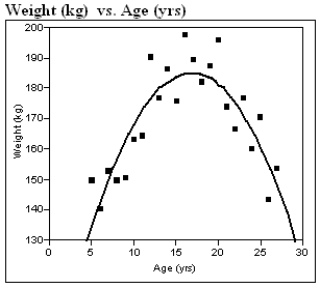Essay
Polar bear cubs are born in the winter in dens, and they must live off the fat stores of the mother even after leaving the den for sea ice, since the availability of their prey is unpredictable. Therefore, maternal weight is an important factor in successful reproduction of polar bears. In a recent spring, 261 adult females with 492 cubs were captured as they left their dens, and the mothers' weight and ages were determined by "counting annuli in the cementum of an extracted vestigial premolar tooth." (We are NOT making this up!) A quadratic fit of the maternal weight in kilograms to age in years resulted in the regression analysis below.  Polynomial Fit Degree=2
Polynomial Fit Degree=2
Weight = 82.920 + 12.134 Age − 0.360(Age )^2 

a)On average, about how far off are the weights of the maternal bears? That is, what is a typical difference between the actual weights and the weights predicted by the quadratic model?
b)If the maternal weight is an important factor as discussed above, what age of the female would seem to be the best for reproduction success? In a few sentences, justify your answer by appealing to the information provided above.
Correct Answer:

Verified
a)s = 9.14 kg
b)The ...View Answer
Unlock this answer now
Get Access to more Verified Answers free of charge
Correct Answer:
Verified
b)The ...
View Answer
Unlock this answer now
Get Access to more Verified Answers free of charge
Q7: The slope of the least squares line
Q16: The coefficient of determination is equal to
Q22: Assessing the goodness of fit of a
Q33: The standard deviation about the least squares
Q57: Twenty-five assembly-line workers participated in a study
Q58: Suppose that the coins analyzed in Exhibit
Q59: The model W = a + bL
Q62: Exhibit 4-7<br>Golden-rumped elephant shrews have long flexible
Q64: Exhibit 4-3<br>Paleontology, the study of forms of
Q65: One should get nice enough grades in